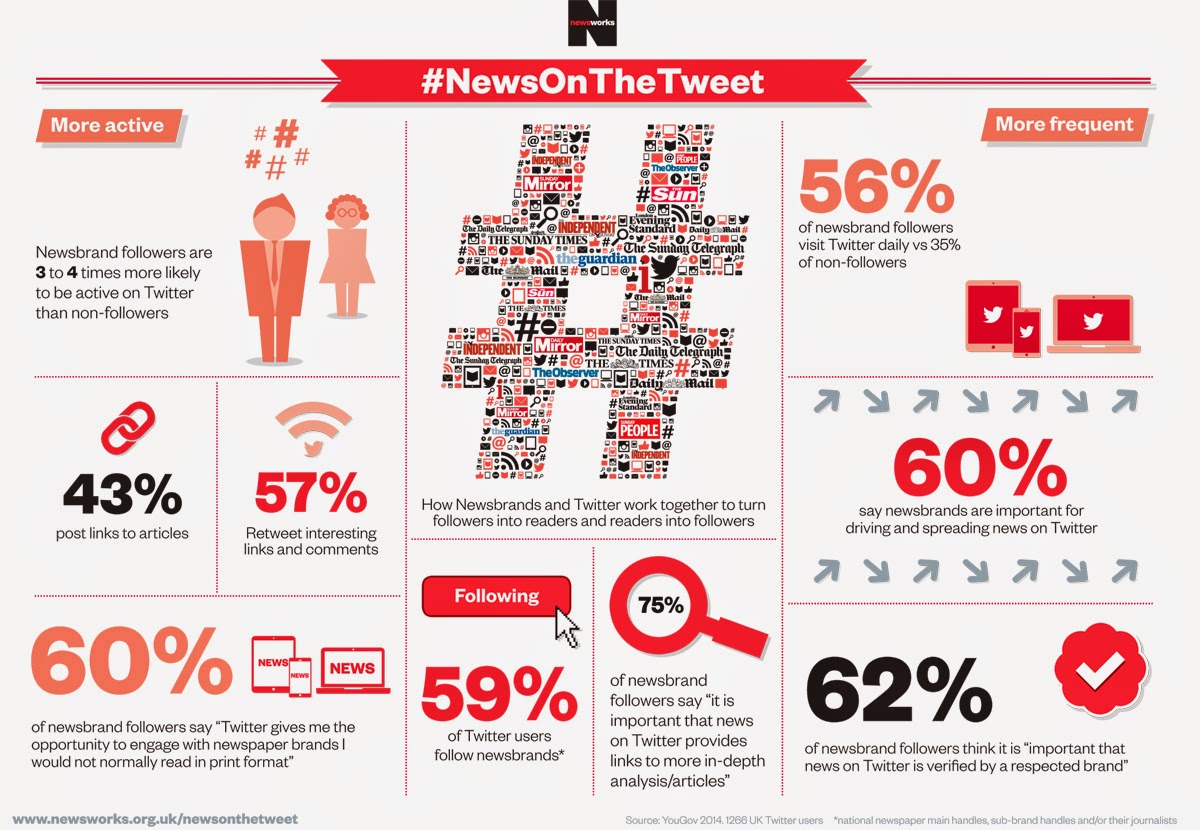NDM case study: News on the Tweet
Our case study on news has focused heavily on the decline of traditional brands and the rise of social media. But do these two competing platforms actually need each other to be successful?
News on the Tweet is a report from Newsworks (a marketing organisation representing newspapers) and Twitter designed to show the positive impact new and digital media can have on traditional media.
Read the report and answer the questions on your blog. Include the News on the Tweet infographic above in your blogpost.
News on the Tweet is a report from Newsworks (a marketing organisation representing newspapers) and Twitter designed to show the positive impact new and digital media can have on traditional media.
Read the report and answer the questions on your blog. Include the News on the Tweet infographic above in your blogpost.
- Why are respected news brands good news for Twitter?
It allows for a highly active and valuable audience. Due to the similar demographics and behaviours between the two audiences it allows for the audience becoming very valuable with 58% more likelyhood of online purchases once a week and 28% more likely to spend 2+ hours online.
News brands provide an important service that twitter users like and need. From things such as providing the 39% of audiences that like to be aware of whats going on in the world with news. It also provides content for the 39% of users that use twitter to pass time as well as providing them with a platform to connect to the people they are interested in but don't know (38%). Thus highlighting how news brands help these audiences receive a personalised, debate fulled and like minded people communities in which twitter users could indulge.
It also thus drives twitters activity where statistics such as 57% of users that follow newspaper brands retweet interesting links and comments compared to 21% of non-followers. Also 22% of followers reply to content posted by newspaper brands and journalists compared to the other 5%.
- Why in turn is Twitter good for respected news brands?
Twitter gives audiences the opportunity to engage with newspaper brands they wouldn't normally read in a print format (60%) ie. helping to make newsbrands more accessible, more influential
and more connected. 55% say this is also true for newsbrands they wouldn't have otherwise even read online.
- The report suggests that old and new media “are not, in fact, in direct competition, but often work extremely well together to enhance both the media eco-system and the consumer experience”. What evidence do they provide to support this idea? Do you agree with it?
Both work together to enhance audience knowledge (eg. by being the first to know) developing opinion (eg. being part of a wider debate on the online community), being part of this larger community (eg. connecting with like minded people) as well as the more light hearted aspect of Banter and gossip.
- On page 24/25 of the report, the focus turns to 'gossip' or 'banter'. What example tweets from journalists are used to illustrate this?
- Do you think the increasing amount of 'gossip' or 'banter' is harming the reputation of news and journalists?
Not a lot, when they keep it to a minimum. Its nice to hear about non-serious stories from time to time and create a relationship between the readers and the jounalists
- What does the report say about trust in Twitter and journalists (look at pages 34-39)?
There is a large amount of trust between the two due to the fact that twitter managed to verify accounts and thus show the audience is they are the original accounts deeming them trust worthy or not eg. bbc news would be verified so audiences would know they can trust the news posted by them but not another account with the same name without verification.
- Do you think new and digital media developments such as Twitter have had a positive or negative impact on traditional newspapers?
A positive impact has happened due to the face that twitter allows for a lead on stories, accounts on them and a possible eye witness however they do have to check the validity of the tweets and accounts which can take a lot of time and effort. Another benefit is that the traditional news paper companies can start up accounts and share their stories and promote them online.
However it has lead to decreased circulation of hard copies decreasing profit for the traditional newspaper organisations and leading to some even closing down because they couldn't strike a balance between the two and couldn't keep posting stories at a fast speed.
However it has lead to decreased circulation of hard copies decreasing profit for the traditional newspaper organisations and leading to some even closing down because they couldn't strike a balance between the two and couldn't keep posting stories at a fast speed.
- Finally, how can we link this report to the vital current debate regarding fake news and Facebook? Do traditional news brands need protecting to ensure there are sources we can trust?
Facebook uses algorithms to recommend stories and put them at the top, by the nature of fake news stories they tend to have a stronger appeal and are shared more frequently thus providing traffic. This means the more honest and reliable traditional news brands that follow rules and regulations are neglected and don't receive the coverage the rightfully deserve thus they do need a protecting so instead the audience are recommended trust worthy news stories by reliable news brands rather than fake news stories.


Comments
Post a Comment